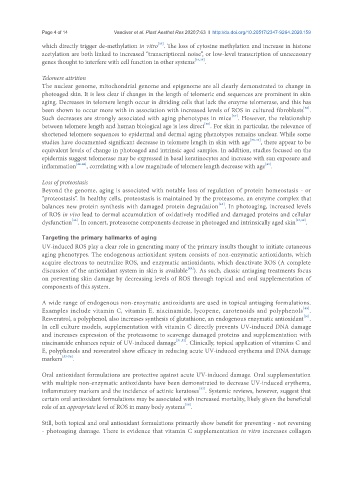Page 740 - Read Online
P. 740
Page 4 of 14 Vandiver et al. Plast Aesthet Res 2020;7:63 I http://dx.doi.org/10.20517/2347-9264.2020.159
[33]
which directly trigger de-methylation in vitro . The loss of cytosine methylation and increase in histone
acetylation are both linked to increased “transcriptional noise”, or low-level transcription of unnecessary
genes thought to interfere with cell function in other systems [34,35] .
Telomere attrition
The nuclear genome, mitochondrial genome and epigenome are all clearly demonstrated to change in
photoaged skin. It is less clear if changes in the length of telomeric end sequences are prominent in skin
aging. Decreases in telomere length occur in dividing cells that lack the enzyme telomerase, and this has
[36]
been shown to occur more with in association with increased levels of ROS in cultured fibroblasts .
[37]
Such decreases are strongly associated with aging phenotypes in mice . However, the relationship
[38]
between telomere length and human biological age is less direct . For skin in particular, the relevance of
shortened telomere sequences to epidermal and dermal aging phenotypes remains unclear. While some
studies have documented significant decrease in telomere length in skin with age [39-41] , there appear to be
equivalent levels of change in photoaged and intrinsic aged samples. In addition, studies focused on the
epidermis suggest telomerase may be expressed in basal keratinocytes and increase with sun exposure and
[43]
inflammation [42-44] , correlating with a low magnitude of telomere length decrease with age .
Loss of proteostasis
Beyond the genome, aging is associated with notable loss of regulation of protein homeostasis - or
“proteostasis”. In healthy cells, proteostasis is maintained by the proteasome, an enzyme complex that
[45]
balances new protein synthesis with damaged protein degradation . In photoaging, increased levels
of ROS in vivo lead to dermal accumulation of oxidatively modified and damaged proteins and cellular
[46]
dysfunction . In concert, proteasome components decrease in photoaged and intrinsically aged skin [47,48] .
Targeting the primary hallmarks of aging
UV-induced ROS play a clear role in generating many of the primary insults thought to initiate cutaneous
aging phenotypes. The endogenous antioxidant system consists of non-enzymatic antioxidants, which
acquire electrons to neutralize ROS, and enzymatic antioxidants, which deactivate ROS (A complete
[49]
discussion of the antioxidant system in skin is available ). As such, classic antiaging treatments focus
on preventing skin damage by decreasing levels of ROS through topical and oral supplementation of
components of this system.
A wide range of endogenous non-enzymatic antioxidants are used in topical antiaging formulations.
Examples include vitamin C, vitamin E, niacinamide, lycopene, carotenoids and polyphenols .
[49]
[50]
Resveratrol, a polyphenol, also increases synthesis of glutathione, an endogenous enzymatic antioxidant .
In cell culture models, supplementation with vitamin C directly prevents UV-induced DNA damage
and increases expression of the proteasome to scavenge damaged proteins and supplementation with
niacinamide enhances repair of UV-induced damage [51,52] . Clinically, topical application of vitamins C and
E, polyphenols and resveratrol show efficacy in reducing acute UV-induced erythema and DNA damage
markers [53-56] .
Oral antioxidant formulations are protective against acute UV-induced damage. Oral supplementation
with multiple non-enzymatic antioxidants have been demonstrated to decrease UV-induced erythema,
inflammatory markers and the incidence of actinic keratoses . Systemic reviews, however, suggest that
[57]
certain oral antioxidant formulations may be associated with increased mortality, likely given the beneficial
[58]
role of an appropriate level of ROS in many body systems .
Still, both topical and oral antioxidant formulations primarily show benefit for preventing - not reversing
- photoaging damage. There is evidence that vitamin C supplementation in vitro increases collagen

